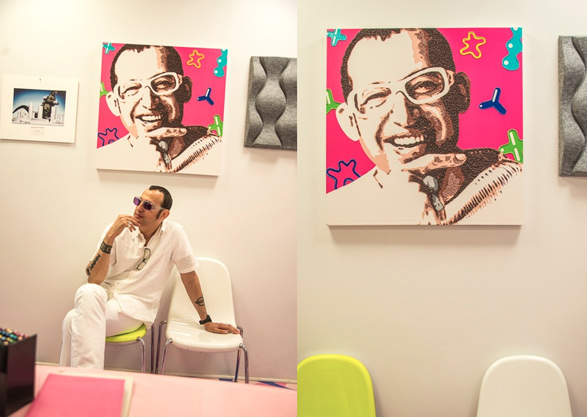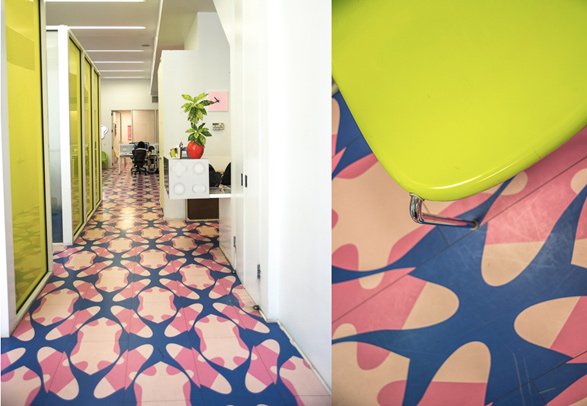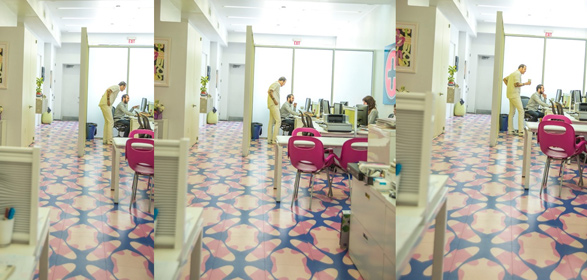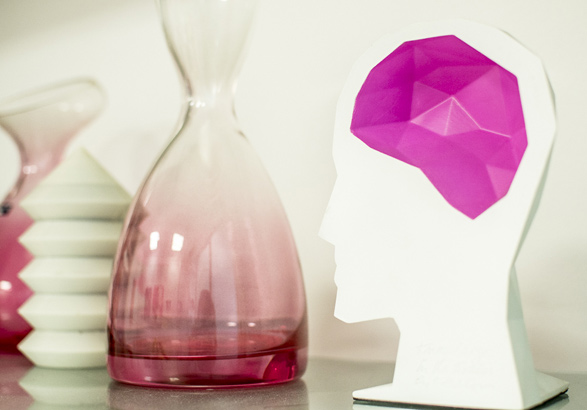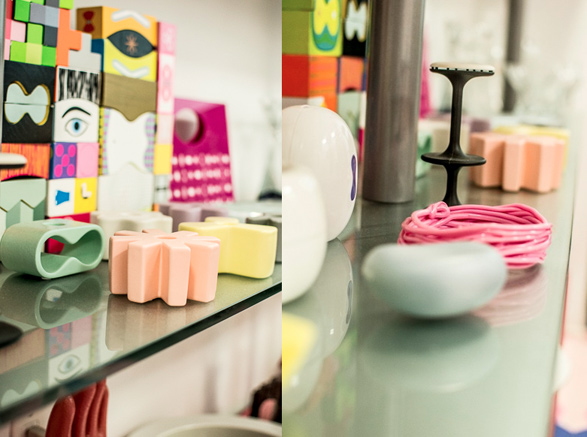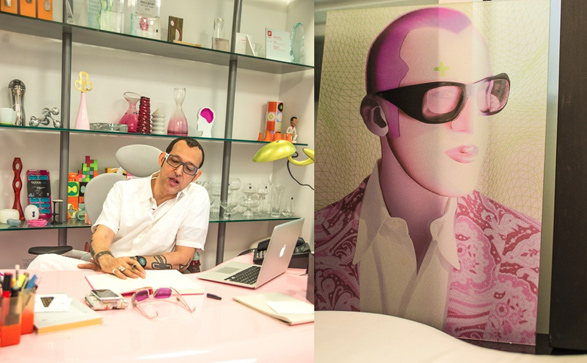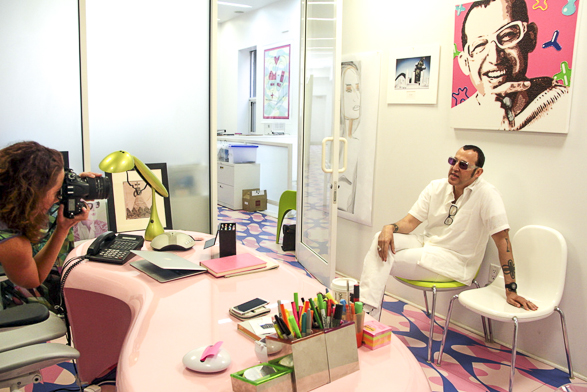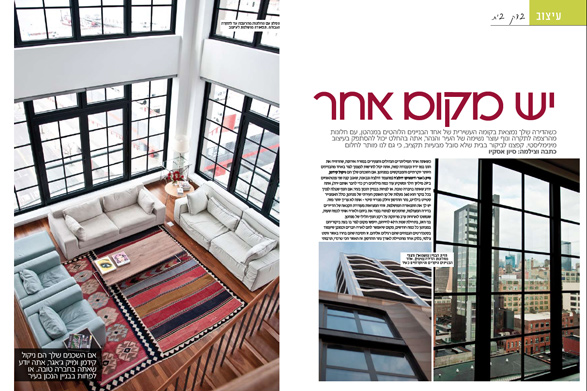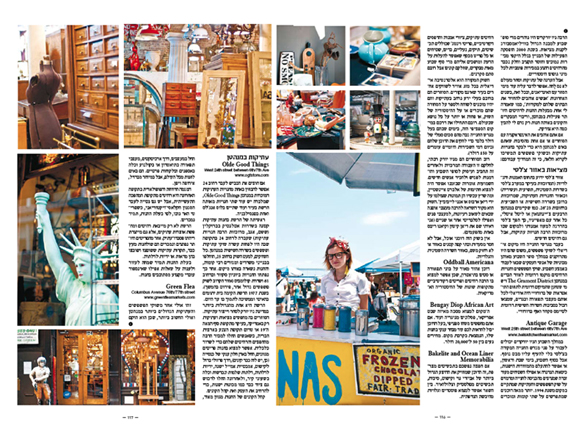When I was writing my previous post about the Nhow Hotel in Berlin, I mentioned that I was always curious to know what does Karim Rashid eat for breakfast that fuels his ideas and inspiration. What I didn’t know was that a week after publishing this post, I would be sitting in Karim Rashid’s studio in Chelsea, asking him this question in person (!).
Apparently, I am not the only one who google-search her name. Karim Rashid does the same. He stumbled upon my blog and saw the pictures I took of Nhow Hotel and asked a permission to post them on his fan page. How could I refuse to such a flattering thing?
‘Don’t ask him why he wears Pink most of the time’ his lovely assistant Jessica advised me when I got to the studio. ‘It’s just because almost every journalist asks him that’, she smiled. I made a note to myself not to mention Pink clothes, but eventually, even though Karim was wearing all white, I used the Pink Clothes-thing just to break the ice.
‘Well, I believe that Real Men wear Pink’ Karim said, and in a way, he had a point. He sat on a yellow chair right under a painted portrait of his, while I was standing behind his pink (!) desk and pointed the camera at him.
As a photographer, when I am taking someone’s portrait, I always want to make that person feel comfortable and at ease (because it shows right away in the picture). Therefore, as much as I can sometimes get nervous myself, I always try to start with a small talk or a funny story to share. ‘So I really want to know what do you eat for breakfast’ I asked Karim, ‘Just to know what fuels your brain in the morning for inspiration’
‘Well, my breakfast is quite boring, I eat oatmeal and fruits, nothing special…But I get my inspiration from almost everything. Since I was a little kid I used to observe what was around me and constantly draw. The ability to look at things different than other people…you Sivan, are probably aware of it yourself because you are a photographer’
So this is how the interview started…smooth with a mutual artist bonding and a clear understanding that we both look at things different. (note: part of the interview was done on the spot, some details were added afterwards via emails)
What is your approach when you design a hotel? With hotels I design from micro to macro (from the lamp to the bed to the interior to the architecture). I love the larger experiential impact a hotel can have on people lives. With hospitality design or public space, I know that masses of people have access to my designs, and they aren’t just looking at it, they are physically immersing themselves inside my concepts. As a designer you must learn to collaborate. As you can see, I try to experiment with every project. It is not the form that is primary -It is the idea, the concept. I work with the strengths of the client, with their vision and location.
How do you start a new project? I perpetually observe and analysis and dissect everything around me in our built environments. My discipline is to absorb everything I can about a particular subject, and then I sketch for hours developing ideas and most important I think about the human experience, about the social behavior of that particular scenario. Every project is different and usually the process is also. I fill sketch books weekly, and then I bring my designs back to the studio. My team creates 3D renders of my ideas, does research with me on materials, production processes, and then we refine the concepts based on all the plethora of criteria, be it social, economic, or technological issues until my vision is realized.
Where do you get your inspiration from? I learned from a young age to be highly perceptive of our built environment. I drew constantly as a child and trained myself to see everything and to see what most people may not see. Hence when you see everything around you, then everything is inspiring and I become critical of every aspect of daily life. Also each project stems from its own inspiration. Nhow hotel Berlin was inspired by location, and by music. Berlin embodies the spirit of the underground, the dark school of electronic music, the harsh yet intellectual environment, the massiveness, and the desirous need for artistic pursuit. Semiramis was inspired by the sensual Greek Light – so romantic, so beautiful.
What is the difference in designing a hotel than any other building? I love the larger experiential impact a hotel can have on people lives. With hospitality design or public space, I know that masses of people have access to my designs, and they aren’t just looking at it, they are physically immersing themselves inside my concepts. With hotels I design from micro to macro (from the lamp to the bed to the interior to the architecture). Sometimes I design the name, the logo, and brand identity. Of course I cannot touch every experience with a condo, office, or other building and it is a longer more permeant relationship with the user. Also the interesting phenomena of hotels is that I believe one should have a temporary experience that they would never have anywhere else, so there is an opportunity to create a new inspiring experience, like theatre or entertainment, and to propel people into living in a space that stye would have never experienced at home or other places.
What are the next trends in hotel design? (in general) I prefer design that transcends fashionable trends and to work towards and searching for new vernaculars that echo out Technorganic digital world. Just the five major features of the perfect hotel – a real contemporary well designed room that is seamless (perfect lighting, perfect comfort, etc), A heightened sensory experience, sustainable construction and operations, total seamless technology, nude sunbathing deck, and a really well considered and designed gym and spa.
Do you have a favorite hotel you prefer to stay in? (not necessarily one you designed) I have stayed in so many hotels and few are really memorable. I do like Unique hotel in San Paolo – The round 2 meter porthole windows have this beautiful unconventional way of seeing the city from room view, like looking out of a big telescope, while the façade has of course some bizarre nautical semantic. The upside-down half pie clad in green copper (locally they refer to it as a watermelon slice) is really, well, unique. What is so fabulous is the end rooms have curved floors that ride up to infinity, giving this sense of nirvana. I feel like I am in heaven. The lobby is a phenomenal grandiloquent space, and the landscaping is reductive yet poetic. My friend Ruy Ohtake created a fantastic project. Hotel Unique also has a floating glass framed rooftop pool with breathtaking views of Sao Paulo.
What is your motto in life? Globalove
What is your motto in work? I think my mantra is to inspire people through my design and my words
What drives you forward? (not necessarily work related) I have so many things I want to do like own a fashion clothing line, open an organic café, design a private house, design more buildings, design an electric car, etc.
Who and what inspires you? Is there someone in specific? Everything and everyone inspires me. I see beauty in everything!
What kind of advice will you give a young designer? Talent and hard work is the way to succeed.I learned that design is not about a form or shape, but it is a cultural critique, a cultural shaper, a faction of social, political, and economic life. Design is a lifetime experience so learn to learn, and work for others to get as many experiences as you can. Diligence and perseverance is a necessity.
Looking back at your career, would you do something different? I would have found my true self sooner.
If you weren’t a designer… what would you be? When I was a child I wanted to be a mathematician if I was not a designer, but now I would consider being a musician or a motivational speaker or a stand up comic – haha
What do you wish for yourself for the future? I have so much I want to do. I want to design an electric car, low-income housing, a museum, more hotels, art galleries, a fashion line under my name, an eyeglass line, a shoe line, etc. I think every artist, designer, always wants to contribute something to culture and make an original mark.

